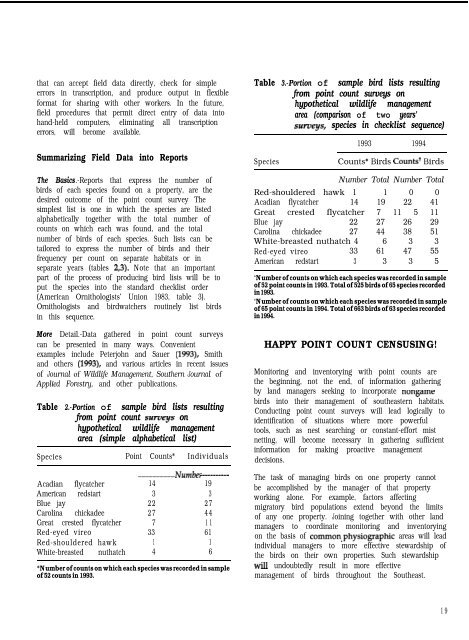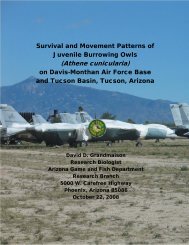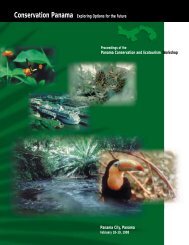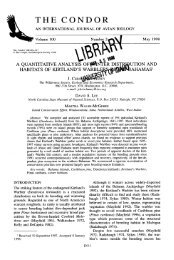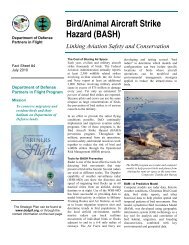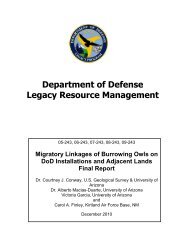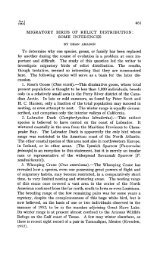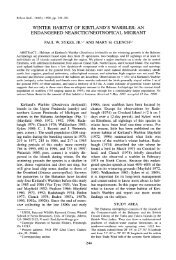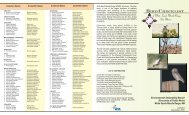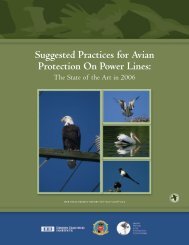A Land Manager's Guide to Point Counts of Birds in the Southeast
A Land Manager's Guide to Point Counts of Birds in the Southeast
A Land Manager's Guide to Point Counts of Birds in the Southeast
You also want an ePaper? Increase the reach of your titles
YUMPU automatically turns print PDFs into web optimized ePapers that Google loves.
that can accept field data directly, check for simple<br />
errors <strong>in</strong> transcription, and produce output <strong>in</strong> flexible<br />
format for shar<strong>in</strong>g with o<strong>the</strong>r workers. In <strong>the</strong> future,<br />
field procedures that permit direct entry <strong>of</strong> data <strong>in</strong><strong>to</strong><br />
hand-held computers, elim<strong>in</strong>at<strong>in</strong>g all transcription<br />
errors, will become available.<br />
Summariz<strong>in</strong>g Field Data <strong>in</strong><strong>to</strong> Reports<br />
The Basics.-Reports that express <strong>the</strong> number <strong>of</strong><br />
birds <strong>of</strong> each species found on a property, are <strong>the</strong><br />
desired outcome <strong>of</strong> <strong>the</strong> po<strong>in</strong>t count survey The<br />
simplest list is one <strong>in</strong> which <strong>the</strong> species are listed<br />
alphabetically <strong>to</strong>ge<strong>the</strong>r with <strong>the</strong> <strong>to</strong>tal number <strong>of</strong><br />
counts on which each was found, and <strong>the</strong> <strong>to</strong>tal<br />
number <strong>of</strong> birds <strong>of</strong> each species. Such lists can be<br />
tailored <strong>to</strong> express <strong>the</strong> number <strong>of</strong> birds and <strong>the</strong>ir<br />
frequency per count on separate habitats or <strong>in</strong><br />
separate years (tables 2,3). Note that an important<br />
part <strong>of</strong> <strong>the</strong> process <strong>of</strong> produc<strong>in</strong>g bird lists will be <strong>to</strong><br />
put <strong>the</strong> species <strong>in</strong><strong>to</strong> <strong>the</strong> standard checklist order<br />
(American Ornithologists’ Union 1983, table 3).<br />
Ornithologists and birdwatchers rout<strong>in</strong>ely list birds<br />
<strong>in</strong> this sequence.<br />
More Detail.-Data ga<strong>the</strong>red <strong>in</strong> po<strong>in</strong>t count surveys<br />
can be presented <strong>in</strong> many ways. Convenient<br />
examples <strong>in</strong>clude Peterjohn and Sauer (1993), Smith<br />
and o<strong>the</strong>rs (1993), and various articles <strong>in</strong> recent issues<br />
<strong>of</strong> Journal <strong>of</strong> Wildlife Management, Sou<strong>the</strong>rn Journal <strong>of</strong><br />
Applied Forestry, and o<strong>the</strong>r publications.<br />
Table 2.-Portion <strong>of</strong> sample bird lists result<strong>in</strong>g<br />
from po<strong>in</strong>t count surveys on<br />
hypo<strong>the</strong>tical wildlife management<br />
area (simple alphabetical list)<br />
Species <strong>Po<strong>in</strong>t</strong> <strong>Counts</strong>* Individuals<br />
___________ Number ___-___-__<br />
Acadian flycatcher 14 19<br />
American redstart 3 3<br />
Blue jay 22 27<br />
Carol<strong>in</strong>a chickadee 27 44<br />
Great crested flycatcher 7 11<br />
Red-eyed vireo 33 61<br />
Red-shouldered hawk 1 1<br />
White-breasted nuthatch 4 6<br />
*Number <strong>of</strong> counts on which each species was recorded <strong>in</strong> sample<br />
<strong>of</strong> 52 counts <strong>in</strong> 1993.<br />
Table 3.-Portion <strong>of</strong> sample bird lists result<strong>in</strong>g<br />
from po<strong>in</strong>t count surveys on<br />
hypo<strong>the</strong>tical wildlife management<br />
area (comparison <strong>of</strong> two years’<br />
surueys, species <strong>in</strong> checklist sequence)<br />
1993 1994<br />
Species <strong>Counts</strong>* <strong>Birds</strong> <strong>Counts</strong>+ <strong>Birds</strong><br />
Number Total Number Total<br />
Red-shouldered hawk 1 1 0 0<br />
Acadian flycatcher 14 19 22 41<br />
Great crested flycatcher 7 11 5 11<br />
Blue jay 22 27 26 29<br />
Carol<strong>in</strong>a chickadee 27 44 38 51<br />
White-breasted nuthatch 4 6 3 3<br />
Red-eyed vireo 33 61 47 55<br />
American redstart 3 3 3 5<br />
‘Number <strong>of</strong> counts on which each species was recorded <strong>in</strong> sample<br />
<strong>of</strong> 52 po<strong>in</strong>t counts <strong>in</strong> 1993. Total <strong>of</strong> 525 birds <strong>of</strong> 65 species recorded<br />
<strong>in</strong> 1993.<br />
‘Number <strong>of</strong> counts on which each species was recorded <strong>in</strong> sample<br />
<strong>of</strong> 65 po<strong>in</strong>t counts <strong>in</strong> 1994. Total <strong>of</strong> 663 birds <strong>of</strong> 63 species recorded<br />
<strong>in</strong> 1994.<br />
HAPPY POINT COUNT CENSUSING!<br />
Moni<strong>to</strong>r<strong>in</strong>g and <strong>in</strong>ven<strong>to</strong>ry<strong>in</strong>g with po<strong>in</strong>t counts are<br />
<strong>the</strong> beg<strong>in</strong>n<strong>in</strong>g, not <strong>the</strong> end, <strong>of</strong> <strong>in</strong>formation ga<strong>the</strong>r<strong>in</strong>g<br />
by land managers seek<strong>in</strong>g <strong>to</strong> <strong>in</strong>corporate nongame<br />
birds <strong>in</strong><strong>to</strong> <strong>the</strong>ir management <strong>of</strong> sou<strong>the</strong>astern habitats.<br />
Conduct<strong>in</strong>g po<strong>in</strong>t count surveys will lead logically <strong>to</strong><br />
identification <strong>of</strong> situations where more powerful<br />
<strong>to</strong>ols, such as nest search<strong>in</strong>g or constant-effort mist<br />
nett<strong>in</strong>g, will become necessary <strong>in</strong> ga<strong>the</strong>r<strong>in</strong>g sufficient<br />
<strong>in</strong>formation for mak<strong>in</strong>g proactive management<br />
decisions.<br />
The task <strong>of</strong> manag<strong>in</strong>g birds on one property cannot<br />
be accomplished by <strong>the</strong> manager <strong>of</strong> that property<br />
work<strong>in</strong>g alone. For example, fac<strong>to</strong>rs affect<strong>in</strong>g<br />
migra<strong>to</strong>ry bird populations extend beyond <strong>the</strong> limits<br />
<strong>of</strong> any one property. Jo<strong>in</strong><strong>in</strong>g <strong>to</strong>ge<strong>the</strong>r with o<strong>the</strong>r land<br />
managers <strong>to</strong> coord<strong>in</strong>ate moni<strong>to</strong>r<strong>in</strong>g and <strong>in</strong>ven<strong>to</strong>ry<strong>in</strong>g<br />
on <strong>the</strong> basis <strong>of</strong> common.physiographic areas will lead<br />
<strong>in</strong>dividual managers <strong>to</strong> more effective stewardship <strong>of</strong><br />
<strong>the</strong> birds on <strong>the</strong>ir own properties. Such stewardship<br />
wilI undoubtedly result <strong>in</strong> more effective<br />
management <strong>of</strong> birds throughout <strong>the</strong> Sou<strong>the</strong>ast.<br />
19


